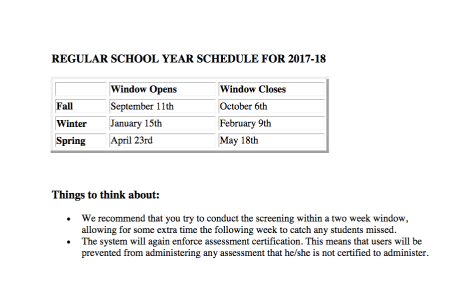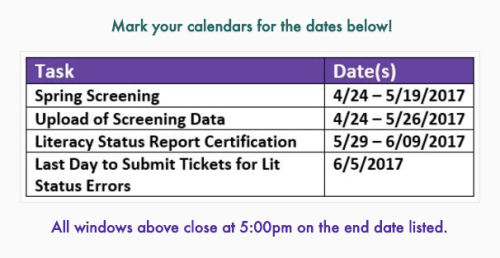From the Iowa Department of Education – November 7, 2017
While ELI requirements for monitoring, intervening, and parent communication have not changed, the recent elimination of required summer school and retention requires a guidance update. In addition, the transition from Iowa TIER to the FAST application means some changes in supports and practices. As we work to update official guidance, here are some tips to help your team use your current data in the FAST system to meet student needs.
How do we identify who is at risk and persistently at risk?
Use the benchmarks. Go to the “Group Screening Report” tab under Reporting, select your default assessment, and look for the students that have the pink ! or !! next to their score for the current screening period – !=below benchmark and !!=far below benchmark. All other students are above benchmark. If you start interventions and monitoring for all the students who are below benchmark you should do well for the students, even though below benchmark is not exactly the same thing as ELI “At risk” and “Persistently at Risk” (PatR requires two windows). Literacy status determination for ELI is still based on the concepts illustrated in the graphic below. The key feature is that the screening results (above or below benchmark) can only move the child up or down one level per screening window.

What about parent communications?
Put your parent hat on for a moment and play out what you’d like to know if your child was found to have an emerging or ongoing concern with literacy. You’d probably like to know that there is a concern, what the school is going to do about it, what can be done about it at home, and how everyone will know if the interventions are working. When you frame the communication this way, you will meet the requirements for most ELI elements:
- Communicate the literacy status and the data used to make that determination.
- Describe what the school is going to do about it.
- Share ideas for things the parent can do at home to support literacy improvement.
- Plan for regular periodic progress monitoring updates to check on the effectiveness of the intervention activities.
What should we do about intervention and progress monitoring?
It is true that ELI says you are not REQUIRED to provide intervention until the child is below benchmark twice in a row, but we’ve always strongly encouraged everyone to go ahead and intervene now, rather than wait and possibly let the gap grow wider for the child between now and the next screening window. For At-Risk students who don’t REQUIRE intervention yet, you might support them by tightening universal instruction or by applying specific interventions right away. The key is that early intervention while problems are smaller means that gaps are easier to close. Waiting may mean larger gaps to close later. If the team chooses to not intervene, watch the progress monitoring data to see if the child is closing the gap or falling further behind and act if needed.
For the students who were Persistently At Risk after the previous screening (last spring) but scored above benchmark in the current screening (this fall), intervention is not required but progress monitoring is required. Monitoring allows you to make sure they don’t fall behind again after the intervention is removed. If a student does begin to falter, the intervention can be reinstated to prevent regression.
How often do we need to monitor progress?
The ELI requirement is weekly progress monitoring for grades K-3, with frequent monitoring encouraged in grades 4-6. The benefit for the child is that weekly data using measures sensitive to improvement on the general reading skill will provide feedback within a few weeks to tell whether or not the intervention is working.
Can we monitor progress off of the student’s grade level?
Yes, but… the practice of monitoring students off grade level has some limitations and quirks. The FAST CBMR measures were intentionally designed to minimize the need to measure off-level. FastBridge developed the progress monitoring passages to be a bit more “readable” in order to get a larger sample of reading out of lower-performing students. A larger sample of reading on easier passages means better sensitivity to growth. As long as the student can read 10 or more words correct per minute on the grade level passage, there should be limited need to use an off-level measure. Generally, about 98% of students should be able to have their reading growth monitored using grade level materials.
Also, be aware that off-grade level progress monitoring goals are based on the grade level of the measure, not the child’s actual grade level expectations. This may produce a false sense that the student is making good progress towards an end of year benchmark that was actually intended for younger children, while actually not closing the gap on the appropriate grade level measure. Even though monitoring on grade level at a lower frequency can help keep an eye on the grade level target, fewer data points means a longer time before it is clear that the intervention is (or is not) working.
What about students we can’t assess because they are on alternate assessment, home school, etc.?
There is no place to mark a reason not assessed in FAST, but you can keep track of this information locally if desired (it is not required). Here are some issues related to decisions to screen or not screen a student with the default assessment.
- Students with significant disabilities (1%) will participate in screening under ELI. Most likely, they will participate in the Early Literacy Alternate Assessment (EL AA).
- English Learners should participate in screening, intervention and weekly progress monitoring K-3. However, during a language acquisition phase, an off-level monitoring measure may be used and may be more sensitive to growth for a limited time.
- Dual-enrolled students with public and private schools are included in the ELI supports and requirements. One of the two sites should screen and offer supports (if applicable) to the student.
- Parents of students in a home-school program should be offered the opportunity for screening and intervention, which they may decline.
Given the inclusion of all students in screening and early literacy, remember it is acceptable to use another approved measure when there is a good educational reason to do so. For example, you can use aReading instead of CBMR for a student with dyslexia (untimed assessment) or for a student who is nonverbal or dysfluent. Or, you can use earlyReading or CBMR if the student should be assessed 1:1 or needs a measure with discontinue rules, rather than an open ended, independently completed measure such as aReading. Using another approved measure to get a better score or “the best” score is not permitted.
An optional form is attached for you to use locally to record assessment information this school year. Please note that this is not a required form and there is no required reporting for this. The form is provided to use if desired:https://tinyurl.com/y9nkw6wd
In conclusion, we hope that this information will be helpful as we all continue the work to improve literacy outcomes for all of our children in Iowa. Thank you for your continued support as we carry out this work to the best of our ability.






 hlights
hlights Hi all!
Hi all!